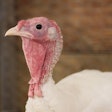
Turkey processors may be able to rely on several plant-based options when it comes to post-harvest Salmonella control, a Minnesota researcher says.
Dr. Anup Johny, associate professor for the Department of Animal Science, University of Minnesota, spoke of several such means during his talk, “Pre-harvest Interventions and Implications of Safety for Turkey Processing,” held August 13 during the Midwest Poultry Federation Convention, which was held virtually.
Johny explained that the majority of pathogens in turkeys and other poultry are usually handled during pre-slaughter operations, there is still the need to control pathogens during and after the scalding and chilling stages due to the potential for cross-contamination.
One of the key aspects of Salmonella is its ability to attach to poultry skin. In both scalding and chilling tanks, Salmonella can attach strongly onto the skin. In addition, the oiliness of the skin facilitates the pathogen attachments, and the organic matter in the tanks reduces the efficacy of disinfectants,” Johny said.
Johny told of a study with which he has been involved. In the study, he and the other researchers are exploring plant-based options, including essential oils.
Johny mentioned five such possibilities:
- Lemongrass essential oil (LGEO) from lemongrass
- Pimenta essential oil (PEO) from allspice
- Trans-cinnamaldehyde (TC) from cinnamon
- Carvacrol and thymol from oregano
- Resorclylic acid from flowering plants
What Johny and his colleagues have found so far is that PEO and LGEO are “highly effective against Salmonella Heidelberg” on turkey drumstick skins and in processing water.
He also said that TC and LGEO have proven to reduce Salmonella Heidelberg in ground turkey patties.
Are essential oils a cost-effective pathogen controller?
When asked if essential oils are a cost-effective way to control pathogens, Johny noted that PEO and LGEO are still relatively expensive products, but other essential oils can be more cost-effective because they are marketed in bulk.
More information on the cost effectiveness will be forthcoming, as Johny’s research team is working with researchers from North Carolina State University on a cost analysis.


















